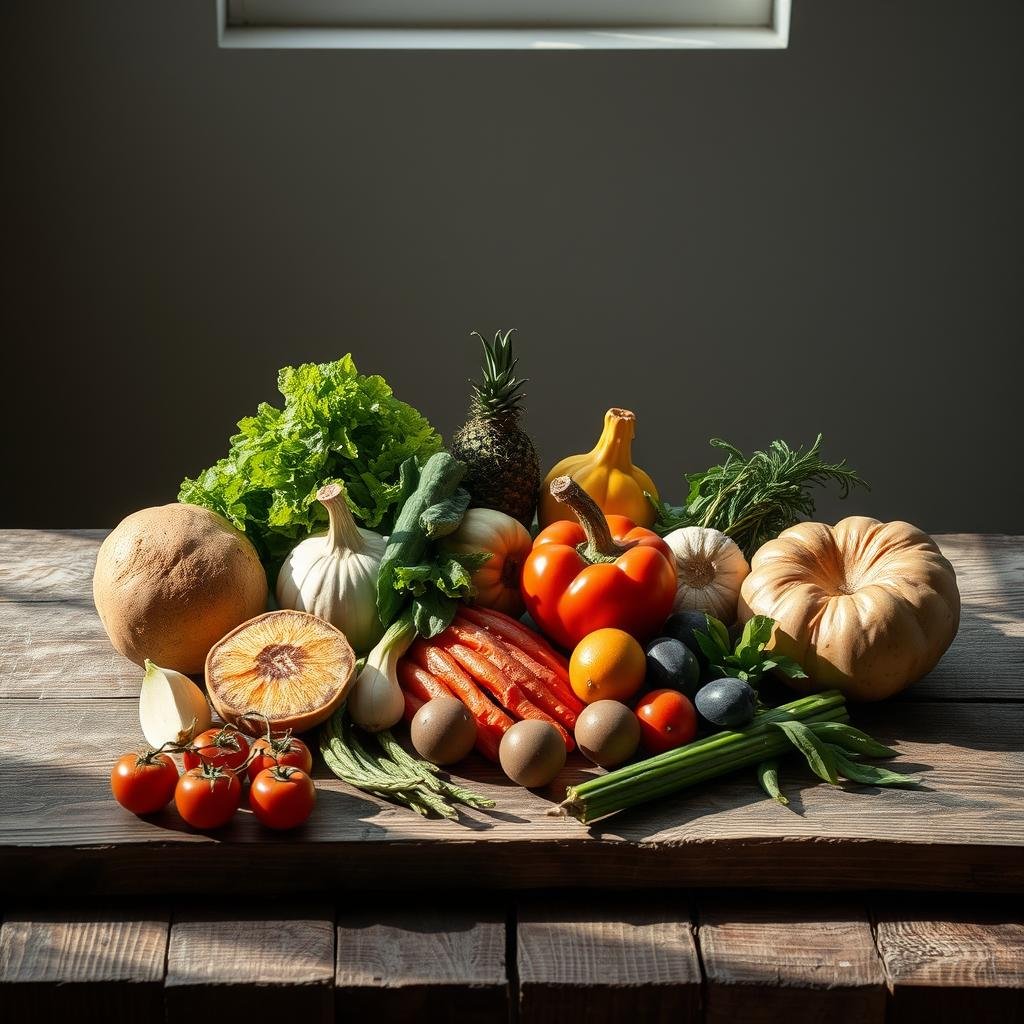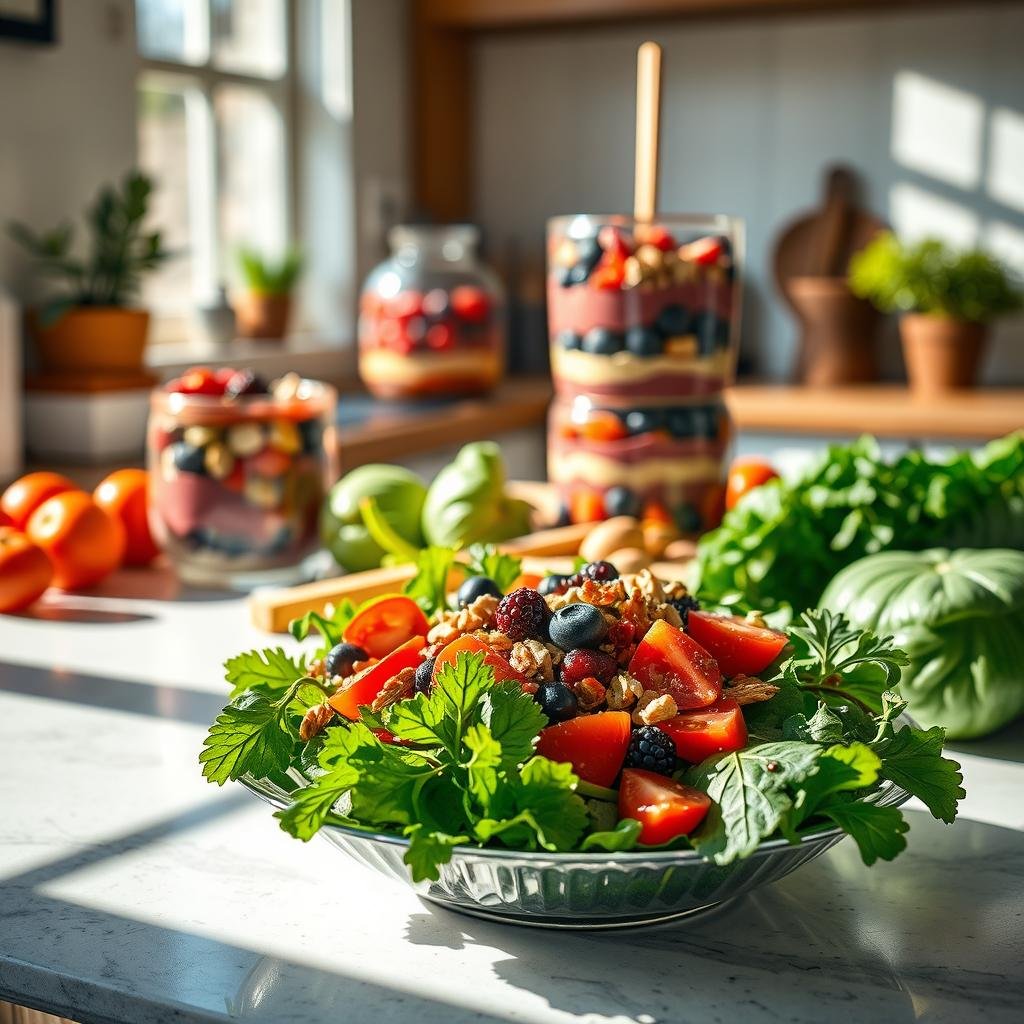Every January, I start thinking about food differently. The new year makes me want to change how I eat and how I see my meals. Healthy eating aesthetics are more than a trend. They make nutritious foods look great and feel good.
I love wellness, and I’ve found that how food looks matters a lot. Making meals that are both beautiful and healthy turns eating into an art. It makes us enjoy our food more and feel better.

In this guide, I’ll show you ten ways to make healthy meals look amazing. These tips are not just about cooking. They’re about creating experiences that inspire and nourish us.
Whether you’re into health, cooking at home, or just want to eat better, these tips will change your meals. You’ll see how making food look good can make eating healthy fun and beautiful.
The Art of Mindful Plating and Presentation

Food presentation turns eating into a special experience. As a home cook, I’ve learned that how we arrange our meals matters a lot. It’s not just about what we eat, but how we enjoy each bite.
The look of a dish is key to our dining joy. Using thoughtful presentation, we can make meals that feed both body and soul. It’s more than just looks; it’s a journey for our senses that makes eating healthy fun.
Color Harmony on Your Plate

Color harmony is a big deal in cooking. I enjoy using bright ingredients to make my meals pop. Think of a plate with orange sweet potatoes, green spinach, and purple beets. Each color adds nutrients and makes eating healthy a treat.
Balancing Textures and Heights
Texture and height turn a flat plate into a lively scene. By layering and varying heights, simple meals can look like they came from a restaurant. A crunchy veggie on top of a smooth puree adds interest and makes eating more fun.
Negative Space Utilization
In food presentation, what’s not on the plate is just as important as what is. Using negative space helps control portions and makes dishes look fancy. View your plate as a canvas, with each piece placed for balance and beauty.
Fresh and Vibrant Ingredients for Visual Appeal

Creating stunning meals begins with the right ingredients. As a food lover, I’ve learned that vibrant colors make healthy eating fun and nutritious. USDA studies show that foods like berries are not only beautiful but also full of antioxidants.
I aim to make my plates pop with a rainbow of seasonal ingredients. Blueberries, raspberries, and blackberries add visual interest and nutritional value. Mixing different colors creates dishes that delight both taste and sight.
Seasonal ingredients add natural beauty to your meals. Summer brings bright red tomatoes and orange bell peppers. Autumn offers deep purple eggplants and golden squash. These colors not only beautify your plate but also provide essential nutrients.
My best advice is to play with color combinations. Pair green veggies with yellow corn or red pomegranate seeds. This turns healthy eating into a creative journey that feeds both body and soul.
Healthy Eating Aesthetics: Creating Instagram-Worthy Dishes

In the world of social media, food presentation is an art. My love for healthy eating makes me turn nutritious meals into stunning visuals. These visuals grab attention and inspire others to live healthier.
Getting the perfect food image is more than just taking a picture. It’s about mastering the techniques that make a dish pop.
Mastering Natural Lighting
Natural light is key in food photography. Soft, diffused daylight makes fresh ingredients’ colors and textures pop. Placing your dish near a window can make it look amazing, showing off its details.
Composition Secrets
The rule of thirds is my favorite for making food look good. It divides the frame into a 3×3 grid. This helps me place elements to balance and guide the viewer’s eye.
Styling with Purpose
Props and backgrounds are important in food presentation. I choose neutral surfaces and simple accessories that match the dish. Using natural textures like wood or marble can make healthy meals look even better.
These methods turn simple meals into stories that celebrate healthy eating. They encourage others to try nutritious and tasty dishes.
The Power of Portion Control Through Design

Design is key in mindful eating and portion control. My clean eating journey showed me a simple yet effective method: using visual cues to manage meal sizes. By choosing the right dishware and understanding plate psychology, you can control your food intake easily.
Using smaller plates tricks your brain into feeling full with less food. A 9-inch plate instead of a 12-inch one can cut portion sizes by up to 30%. This design trick helps you stick to your clean eating goals by stopping you from eating too much.
Color and how food is arranged also affect how much you think you’re eating. Contrasting plate colors against food can make portions appear larger, making you feel fuller with less. Creative plating, like adding height with veggies or using shapes, makes meals look good and keeps calories in check.
Mindful eating is not just about what you eat—it’s about how you eat it. Turning portion control into an art makes healthy eating fun and lasting. The right design makes every meal a thoughtful, fulfilling experience that feeds both your body and mind.
Plant-Based Plating Techniques

Turning plant-based dishes into stunning visuals needs creativity and design. As a food lover, I’ve found that healthy foods can look and taste great. This happens when they’re arranged with care and creativity.
Layering Vegetables and Grains
Building depth in plant-based meals involves mixing colors and textures. Start with a base like quinoa or brown rice. Then, layer roasted veggies in colors that match.
Roasted purple sweet potatoes and bright green kale make a striking contrast. This makes your dish visually appealing.
Creating Height with Fresh Ingredients
Adding height to your dish makes it more eye-catching. Avocados are great for this, adding healthy fats and structure. Try stacking veggies or using spiralized zucchini to add height and interest.
Incorporating Edible Flowers
Edible flowers take healthy foods to the next level. Nasturtiums, pansies, and lavender add color and unique tastes. They also offer nutritional benefits. Sprinkle these flowers on your dish for a presentation that’s both beautiful and Instagram-worthy.
Incorporating Clean Eating Elements in Presentation

When I dive into clean eating, I aim to turn nutritious foods into stunning visuals. It’s not just about looks; it’s about making meals that feed both body and soul.
Clean eating is not just about what you eat. It’s also about how you present it. I suggest using simple preparation to highlight the beauty of unprocessed foods. Imagine crisp veggies, lean proteins, and whole grains that show off their textures.
I love making plates that burst with color, telling a story of healthy foods. Vibrant greens, deep oranges, and rich purples turn a simple meal into a work of art. By focusing on whole ingredients, you’re not just eating—you’re experiencing food in its purest form.
Herbs and spices are key in clean eating presentation. A sprinkle of fresh herbs or a dash of colorful spices can make a dish pop. These small details turn clean eating into a celebration of nature’s bounty.
Remember, clean eating is about connecting with your food. When you present meals that look as good as they taste, you’re more likely to stick to healthy habits. It makes nourishing your body a joy.
Seasonal Table Settings for Healthy Meals
Creating the perfect dining experience is more than just food. Seasonal ingredients turn your meal into a work of art that honors nature’s cycles. Thoughtful table settings can make even simple meals unforgettable.
Crafting Seasonal Décor
Every season offers a chance to create stunning table settings. In spring, I use soft pastel linens and centerpieces with fresh tulips and herbs. Summer brings bright table runners and fruit accents.
Autumn is all about warm tones and small pumpkins. Winter features rich textures and evergreen elements.
Eco-Friendly Place Settings
Sustainable dining is a big deal today. I choose bamboo utensils, recycled glass plates, and linen napkins for elegance and less waste. Using local, seasonal ingredients helps the environment and supports local farmers.
Centerpiece Inspiration
The best centerpieces show off seasonal abundance. Picture a harvest table with roasted vegetable arrangements, edible flowers, and herbs. Guests can enjoy and admire these living centerpieces, celebrating the season and culinary art.
Conclusion
Healthy eating aesthetics are more than looks—they change how we see food. They turn meals into exciting adventures. This new way of eating engages all our senses.
Looking into healthy eating aesthetics, we see that how food looks matters a lot. Making food look good makes us think more about what we eat. It turns every meal into a chance to be creative and healthy.
We’ve talked about how to make food look great, from how it’s arranged to its colors. These ideas help make eating healthy fun and lasting. It’s not about following a strict diet but enjoying healthy foods with passion.
Starting your own healthy eating journey is personal. Try new things, explore, and find what works for you. Seeing food as art is the first step to enjoying nutritious and beautiful meals.
Disclaimer: The information provided on this site is intended for educational and informational purposes only and is not a substitute for professional medical advice, diagnosis, or treatment. Always consult your physician or a qualified healthcare provider before making changes to your diet, fitness routine, or wellness practices. This article may include affiliate links, which help support our platform at no additional cost to you.






